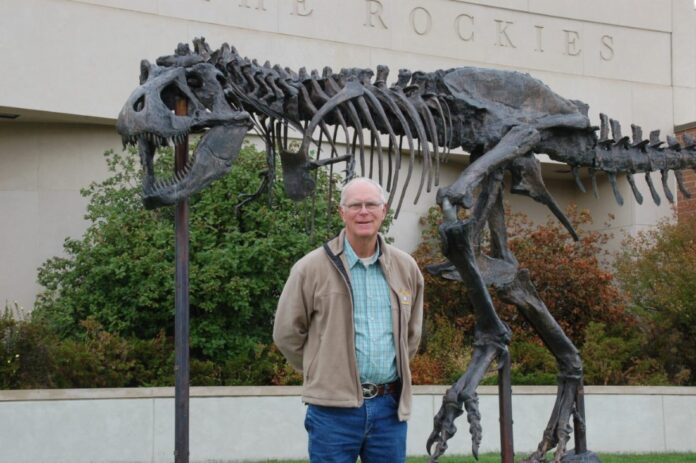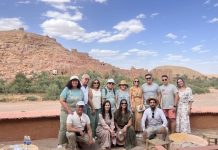PHOTOS BY GARRY BRANDENBURG — Summer vacation destinations can be a long list, to be completed over decades of time. Each, however, will etch a memory about special places on the land and long ago geologic times when life was entirely different. One place this author has visited several times is the Museum of the Rockies in Bozeman, Mont.. Outside the entrance is a cast skeleton of Tyrannosaurus Rex, a 12 foot tall and 40 foot long lizard predator of the Cretaceous Period. Another geologic and outer space rock impact site is near Winslow, Ariz. This author made the image from out the window of his aircraft more than 20 years ago while flying to visit relatives. A 130-foot diameter meteorite 49,000 years ago was traveling at more than 27,000 miles per hour when its 300,000 ton mass struck the earth’s surface in what is now Arizona. The impact left a crater 600 feet deep and .75 miles in diameter. Places like these tease the curiosity of people who may be vacation bound this summer. Check out these sites and many others for adventurous places to learn more about them.
Summer vacation destinations can be close to home, within Iowa’s borders, surrounding states, the nation, or the world. Whatever your interest level, there is something for everyone, so let’s take a journey together to investigate places with special scenic, natural history stories to tell, and unique vegetation forms on the landscape.
Every one of these potential sites has a host of things to offer to those curious about nature and the rocks that tell stories of long past geological events. To start with, close to home, an entire summer could be spent locally visiting county parks, hiking each for trails, camping, fishing and campfire watching while marshmallows sizzle over the fire.
Contact the Marshall County Conservation Board office at the Grimes Farm and Nature Center to gather brochures and ask questions about forests, wetlands, trails, prairie lands and historic sites. Each has unique plant life, many with lots of native vegetation and the wildlife that uses those habitats. Many of those sites have a geologic story to tell of how the land was formed and how glaciers impacted the shape and bedrock.
For example, Three Bridges County Park has a time capsule of information written in its limestone layers telling of warm shallow ocean waters depositing over millions of years the tiny skeletal remains of once living crinoids, starfish and clams. Those rock shapes also tell of ocean currents creating cross-bedding layers, and the limestone itself helped dissolve rain water over geologic time to form carbonic acid that eroded vertical shafts and horizontal bedding plane mini caves.
At the Marietta Sand Prairie, the native prairie grasses and flowers tell of a landscape greatly impacted by severe scouring winds coming off the floodplain of Minerva Creek during post glacial winter time episodes of the last 15,000 years. Wind blown fine grain sand particles were deposited as dune-like humps on top of older soil surfaces, burying everything as sand accumulated. The Sand Prairie has at a minimum more than 250 plant species including several endangered plants in the fen area.
Grammer Grove has its own stories of past glacial times. A very large glacial erratic, a huge stone, was left to melt from the icy glacier of one of the many glacial episodes that impacted Iowa during the last 2.6 million years. As time gets older, geologists have a harder time putting
the clues together of where a rock came from and how it got to where it is now.
What is known is that frozen inside glacial ice is a transport mechanism for all kinds of stones, large and small, from origins most likely of the surface bedrock of Canada. Geologists know that at least 33 glacial advances, and 33 interglacial retreats, have happened during the last 2.6 million years. Grammer’s big boulder is exposed by the natural erosion of soil as a small creek was forming off the uplands. Over time, the rock was exposed. Many school groups have seen this big rock during past field trips.
If one ventures out a bit, state parks surround us in close driving distance. Union Grove State Park is north of Garwin where camping, lake fishing and a swimming beach are offered. Hardin County has Pine Lake State Park with its two lakes, upper and lower, improved camping sites and picnic facilities, hiking trails and Iowa River access for canoes or kayaks. Rock Creek State Park is near Kellogg in Jasper County. Its lake offers good fishing, camping and more trails. Iowa has state parks between its borders that have an amazing array of interesting reasons to visit, to stay, to learn and to enjoy.
Federal lands exist in a few Iowa locations. Effigy Mounds Historical Site is near McGregor in the far northeast corner. Mounds of earth were built by Native Americans at this site overlooking the Mississippi River. Not too far from Marshall County are effigy mounds in Hardin County that have the same characteristics of animal shaped earth memorial sites to tribe members who passed away. The Neal Smith National Wildlife Refuge near Prairie City is a multi-thousand acre rolling hills site with reconstructed prairie, oak savannas, an interpretive center and of course, a drive through wildlife exhibit for bison and elk.
Fossils can be a huge reason to visit some places on the map. Iowa has its Rockford Fossil and Prairie Park Preserve, located 1.5 miles southwest of Rockford. Collecting is allowed by the public because fossils are so abundant. All that underwater oceanic life from the Devonian Period is on display.
The area was the site for over 60 years from 1910 to 1970. Gray-blue shale beds were mined to produce bricks and agricultural drainage tile. After the site closed, its natural attractions were transformed into a preserve. One can find bryozoans, gastropods, cephalopods, crinoids and brachiopods, all free to take home.
Near the outlet of the Coralville Lake at Iowa City, a gorge was cut by flood waters overflowing the emergency spillway of the lake. Floodwaters were intense due to 48 inches of rain between April 1, 1993, and continuing for the next five months! Water out of the spillway was tagged at 130,000 gallons per second.
Within hours, all downstream soils were eroded away down to Devonian bedrock. The spillway water continued unabated for 28 days. Left in its path were exposed Devonian rock surfaces and exposed fossil evidence of past life in shallow ocean environments. The Devonian rocks had been buried for 385 million years, and now it was exposed by a single flood event.
Similar fossils as found at Rockford can be found at Coralville, but two unique items are to be added to the list. First is Hexagonaria, an extinct coral colony, and there was a predator, slow but mighty, to eat sea life animals.
It was a type of fish and was named Dunkleosteus by scientists. It was 35 feet long, weighed four tons and had jaws capable of producing 80,000 pounds of crushing force per square inch. This creature had no teeth, just sharp bony plates to slice through bones and flesh. This fossil gorge site is maintained by the U.S. Army Corps of Engineers.
There are many other geologically interesting places in the Midwest or across the nation, whereby the story of how the earth was formed is told in rock layers of many types. The nice thing about rocks is that they do not lie. They tell the truth, if one takes the time to learn how to read its “pages” of time capsules, and fossils many times are located within
certain rock layers that help tell geologic time frames.
Not too far away from Iowa is the Ashfall Fossil Beds State Historical Park near the town of Orchard, Neb. It is located 100 miles west of Sioux City on Highway 20 and then about seven miles north. This park is the site of a large assemblage of grassland animals (similar to an African plain today) where barrel-chested rhinos once lived along with several types of primitive horses, wild dogs, crowned cranes, camels, horned deer, four-tusked elephants and saber-toothed cats.
What happened next was the story of how these animals died and were preserved. What is now called the Yellowstone hotspot was a volcanic crust point deep within the earth over which the North American plate was sliding westward. At the point 11.83 million years ago, that hotspot erupted in what is now southwest Idaho. It made the Mount St. Helens eruption of 1980 look like a small puff.
This volcano has been named Bruneau-Jarbridge, and it ejected an estimated 25 cubic miles of ash into the atmosphere. Winds blew this fine ash eastward over Idaho, Wyoming, South Dakota, Kansas and Nebraska toward Iowa, leaving a thick layer of fine microscopic dust-like glass shards in its wake. Some of those fine ash particles have been found in deep sea sediments of the Atlantic Ocean. As for Iowa, numerous glacial advances have erased that volcanic ash from our records. But in Nebraska, at the edge of many glacial free zones, the ash persisted.
The ash of this Idaho volcano can be identified by its specific composition wherever it fell, and when this cloud of wind driven ash reached the northeast Nebraska area and the animals that lived there, the ash deposits of from one to six feet thick were wind whipped into great accumulations.
Animals that inhaled the ash got it into their lungs quickly. Small animals suffocated almost immediately. Gophers underground lasted longer, but in the end they died. Larger animals ingested the ash to live longer but suffer intense bone malformation.
Among those animals were the camels, horses, deer, large cats and the barrel-chested rhinos. They died together at an old waterhole and were buried deeply. That is what also preserved them.
The University of Nebraska at Lincoln has since built a large steel frame building over the major excavation. This allows anthropologists year around access for detailed work. In this exhibition building one can now see in situ positions of over 350 animals. Colored charts and poster art along the building’s walls depict what those animals looked like in real life during their Miocene existence.
The list of places to visit is endless. However, I will leave you with a few other names of places I have visited: the La Brea Tar Pits in Calif.; Sternberg Museum of Natural History in Hays, Kan.; Mammoth Site at Custer, S.D.; the fossil collection in downtown Hill City, S.D.; Dinosaur National Monument in Utah; Ginkgo Petrified Forest State Park in Washington State along the Columbia River; Kilauea Volcano, HI; Monument Rocks, Kan.; Mammoth Cave, Ky.; Sioux Quartzite, Minn.; White Sands, N.M.; Carlsbad Caverns, N.M.; Mount St. Helens, Wash.; and Devils Tower, Wyo.
These geologic sites and fossil graveyards are excellent destinations. Make it a point to travel to one or several of them as your inquisitive natural history appetite desires. Have a great summer learning about earth’s natural history. Enjoy.
——
“Science proceeds one funeral at a time.” — Max Plank, professor (That was his summary of how old entrenched axioms slowly give way to new evidence. In science, even cherished ideas must stand up to the test of new evidence).
——
Garry Brandenburg is the retired director of the Marshall County Conservation Board. He is a graduate of Iowa State University with a BS degree in Fish & Wildlife Biology.
Contact him at:P.O. Box 96
Albion, IA 50005
PHOTOS BY GARRY BRANDENBURG — Summer vacation destinations can be a long list, to be completed over decades of time. Each, however, will etch a memory about special places on the land and long ago geologic times when life was entirely different. One place this author has visited several times is the Museum of the Rockies in Bozeman, Mont.. Outside the entrance is a cast skeleton of Tyrannosaurus Rex, a 12 foot tall and 40 foot long lizard predator of the Cretaceous Period. Another geologic and outer space rock impact site is near Winslow, Ariz. This author made the image from out the window of his aircraft more than 20 years ago while flying to visit relatives. A 130-foot diameter meteorite 49,000 years ago was traveling at more than 27,000 miles per hour when its 300,000 ton mass struck the earth’s surface in what is now Arizona. The impact left a crater 600 feet deep and .75 miles in diameter. Places like these tease the curiosity of people who may be vacation bound this summer. Check out these sites and many others for adventurous places to learn more about them.
Today’s breaking news and more in your inbox










